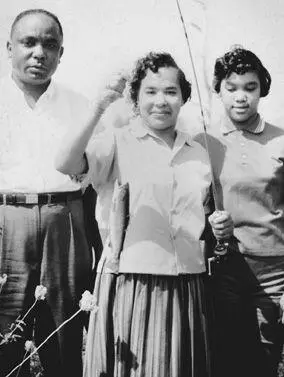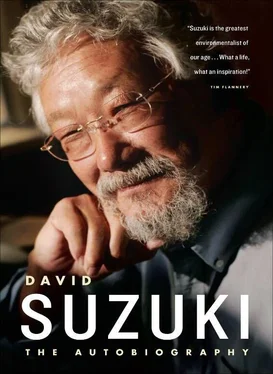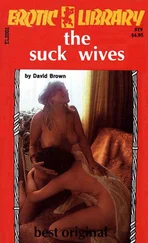
My Oak Ridge lab companion, Ruby Wilkerson; her husband, Floyd; and her daughter,
Patricia with trout at Dad's pond near London
Although I could have stayed on at Oak Ridge and had been offered several faculty positions in the U.S., I felt deeply estranged from the culture because of the overt racism. Even though Canada had invoked the War Measures Act against Japanese Canadians, the country was smaller, and I believed there was more of a chance to work for a better society. The opportunities for a scientist in the U.S. were much greater at that time, but I have never regretted my decision to return home.
A position as assistant professor arose in the Genetics Department at the University of Alberta, which I eagerly applied for, and I was gratified to be offered the job. I accepted it. Edmonton was an excellent place to begin my career, although I took a cut in pay compared with what I would have received had I stayed at ORNL. The province was booming and provided far more support for research and staff than most universities received. When I arrived in the summer of 1962, I would leave the lab at 2:00 or 3:00 in the morning and was thrilled that it was still light out because of Edmonton's northerly latitude. I was not so happy when I was assigned to teach an Introductory Genetics course to a group of agriculture students, but they turned out to be the hardest-working and hardest-playing group I've ever had.
However, that winter, the thermometer plunged to minus forty degrees Fahrenheit, a temperature I had never experienced and did not wish to experience again. So when a position came up at the University of British Columbia (UBC), I applied and was invited out for an interview. When I left Edmonton to try for the job, the temperature was minus thirty degrees. I arrived in Vancouver, where it was thirty above, and everyone was moaning about the cold! I took the job but also another pay cut. It was a good thing I stayed at UBC, because at the rate I was going, I might have ended up having to pay for a job.
When I had taken up the position in Edmonton in 1962, I applied for a research grant from the National Research Council (NRC) in Ottawa and was shocked to be awarded only $4,200. I was told later that a first-time grant for a new professor was $3,500, but since I'd had a year of postdoctoral studies, mine had been bigger. It was a shock because, at that time, the people with whom I had graduated in the U.S. were receiving first-time grants of $30,000 to $40,000. Canada had simply not moved into the post-Sputnik era, as the U.S. had, with a huge commitment to science as part of the Cold War competition.
Canada's granting policies had grown up when there was far less research money to support a small community of poorly paid scientists who did research simply because they loved it. In Canada, one aged into respectability — the longer one hung in doing research, the bigger the grants became. When I returned to Canada in 1962, heads of departments often held the really big grants, even though they were usually fully occupied with administrative duties. They were powerful because of the money they controlled and the people they could support and hire.
That has slowly changed. In those early days in Canada, University of Toronto microbial geneticist Lou Siminovitch worked hard to get better support for junior scientists. He attracted a top-notch group of young people to the University of Toronto, and I believe his advocacy of better support for such researchers was part of the reason my own grants began to rise as the lab became productive. Lou recognized that Drosophila (fruit fly) genetics would be an important area of molecular interest and offered me a position at the University of Toronto that would have led to increased grants and support. But I really loved British Columbia and couldn't see living in a large city.
Canada did have Nobel laureates in science, the most famous being Frederick Banting and John Macleod in 1923 for their discovery of insulin. It was the Nobel Prizes awarded to University of Toronto chemist John Polanyi in 1986 and UBC DNA chemist Michael Smith in 1993 that galvanized greater support for research. In 1972, the Senate Special Committee on Science Policy headed by Senator Maurice Lamontagne had released its recommendations, and among them was greater emphasis on “mission-oriented research”—that is, research dedicated to a specific goal.
The problem with that approach is that science does not proceed from experiment A to experiment B to C to D to a cure for cancer. If it did, we would have solved most of the problems of the world by now. Science cannot proceed in this linear manner. From the moment we begin experiment A, we have no idea what the results will be or where we will end up. The way we maximize “return on our investment” is by supporting top people, not top research proposals. Increasingly, universities are encouraging arrangements in which academics are supported by money from the private sector — in forestry, agriculture, pharmacy, biotechnology, and so on. This policy has had a negative effect on the open, free flow of discussion, criticism, and information that is the essence of a university community.
At the very beginning of my career, I was ambitious and determined to make a mark, not to make money or acquire power but mainly to receive the approbation of the scientists I most admired in Drosophila genetics. But I simply would not have been able to carve out a career on such a piddling grant as $4,200 from the National Research Council, and I reluctantly began to make inquiries about positions back in the U.S.
Then the picture changed. As I was leaving Oak Ridge in 1962, George Stapleton, an administrator I had come to know, had advised me to apply to the U.S. Atomic Energy Commission (USAEC) for research money. Once I got to the University of Alberta, I applied to USAEC, but I did not expect to receive any money, because I was doing basic genetics that did not involve radiation in any way. To my surprise and delight, I received a substantial grant, about ten times my NRC grant and certainly enough to get my lab off the ground. It is such an irony that the U.S. gave me, a foreigner, the support that enabled me to remain in my own country.
I had worked day and night at ORNL, and there were always other people around working just as hard. When I took my academic position in Canada, I was confident in my abilities as a teacher and scientist and anxious to make a name in research, so I continued to work in the lab into the evenings and on weekends. Students responded to this example and worked right along with me, so the lab was lit up well after my colleagues and other students in the department had gone home.
I was still in my late twenties when I arrived at UBC in 1963. Faculty members in the Zoology Department wore jackets and ties, and their students addressed them as “Doctor.” I certainly did not wear a jacket and tie, and my students called me by my first name. This more “American” style was frowned upon. I was never caught up in the social sphere with other staff either, because I was so enthralled with setting up my own lab and getting our research off the ground. The Canadian faculty still acted like a small, exclusive club. I felt disgusted at a meeting when another professor boasted that we were one of the best zoology departments in Canada. I was only interested in being among the best in the world.
Evenings were the best time to be in the lab. No one, including me, had classes then, so we could count fruit flies, drink coffee, and talk — my, how we talked, mostly about genetics but also about sex, politics, and the world. With the revolution in molecular biology, we were all agog at what was being found and kept hatching crazy ideas for experiments. The students I attracted were enthusiastic, and the lab became a kind of family. We worked hard, but we also played hard, going to the pub, skateboarding in the basement, camping together on weekends and in the summers.
Читать дальше



![David Jagusson - Devot & Anal [Hardcore BDSM]](/books/485905/david-jagusson-devot-anal-hardcore-bdsm-thumb.webp)









